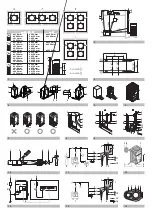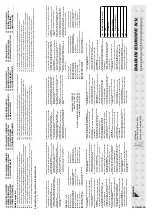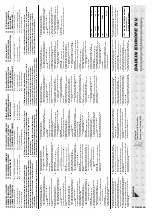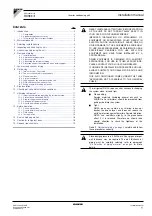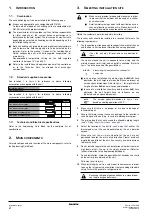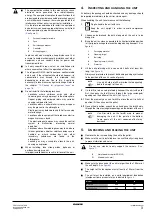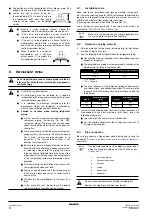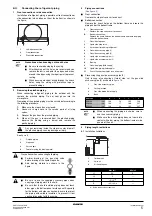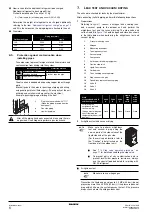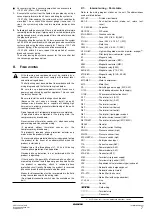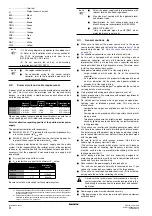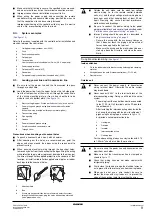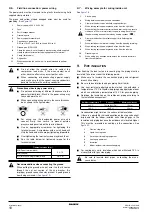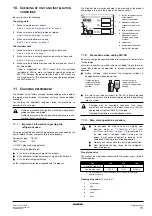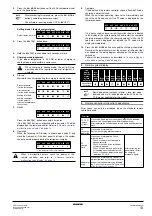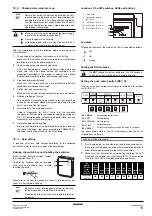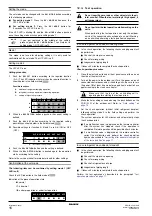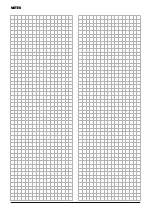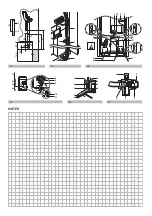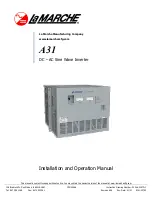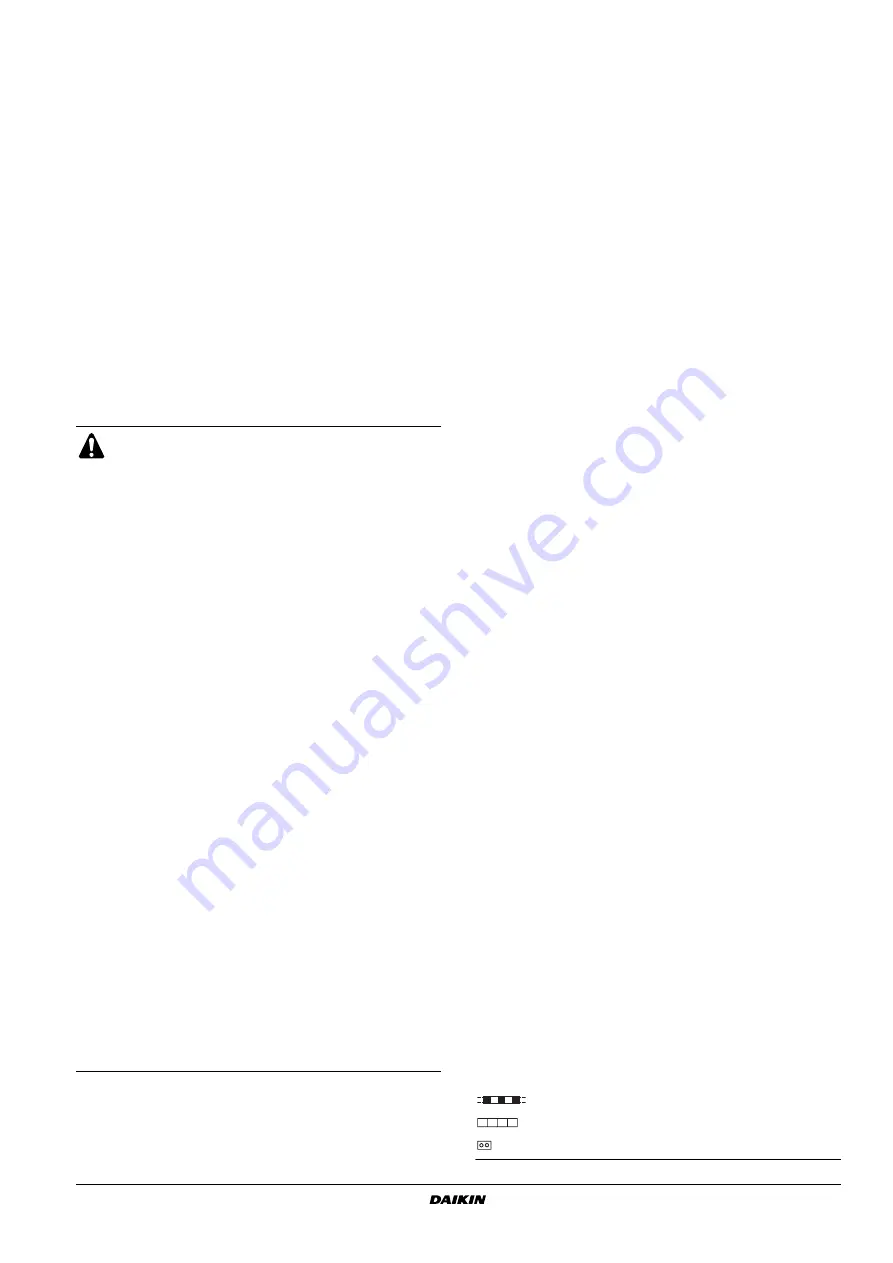
ERX125~250A7W1B
Inverter condensing unit
4PW30064-1D
Installation manual
7
■
Vacuum drying: Use a vacuum pump which can evacuate to
–100.7 kPa (5 Torr, –755 mm Hg)
1.
Evacuate the system from the liquid and gas pipes by using a
vacuum pump for more than 2 hours and bring the system to
–100.7 kPa. After keeping the system under that condition for
more than 1 hour, check if the vacuum gauge rises or not. If it
rises, the system may either contain moisture inside or have
leaks.
2.
Following should be executed if there is a possibility of moisture
remaining inside the pipe (if piping work is carried out during the
raining season or over a long period of time, rainwater may enter
the pipe during work).
After evacuating the system for 2 hours, pressurize the system
to 0.05 MPa (vacuum break) with nitrogen gas and evacuate the
system again using the vacuum pump for 1 hour to –100.7 kPa
(vacuum drying). If the system cannot be evacuated to
–100.7 kPa within 2 hours, repeat the operation of vacuum
break and vacuum drying.
Then, after leaving the system in vacuum for 1 hour, confirm that
the vacuum gauge does not rise.
8.
F
IELD
WIRING
8.1.
Internal wiring – Parts table
Refer to the wiring diagram sticker on the unit. The abbreviations
used are listed below:
A1P~6P.................. Printed circuit board
BS1~5 .................... Push button switch (mode, set, return, test,
reset)
C1,C63,C66 ........... Capacitor
DS1,DS2 ................ DIP switch
E1HC,E2HC ........... Crankcase heater
F1U ........................ Fuse (250 V, 8 A, B) (A4P)
F1U,2U................... Fuse (250 V, 3.15 A, T) (A1P)
F5U ........................ Field fuse
F400U .................... Fuse (250 V, 6.3 A, T) (A2P)
H1P~H8P ............... Light emitting diode (service monitor - orange)
(1)
HAP........................ Pilot lamp (service monitor - green)
K1........................... Magnetic relay
K2........................... Magnetic contactor (M1C)
K2M........................ Magnetic contactor (M2C)
K1R ........................ Magnetic relay (K2M)
K3R,K4R ................ Magnetic relay (Y1S, Y2S)
K7R,K8R ................ Magnetic relay (E1HC, E2HC)
L1R ........................ Reactor
M1C,M2C ............... Motor (compressor)
M1F........................ Motor (fan)
PS .......................... Switching power supply (A1P, A3P)
Q1DI....................... Earth leakage breaker (field supply)
Q1RP ..................... Phase reversal detection circuit
R1T ........................ Thermistor (air) (A1P)
R1T ........................ Thermistor (fin) (A3P)
R2T ........................ Thermistor (suction)
R4T ........................ Thermistor (coil-deicer)
R5T ........................ Thermistor (coil-outlet)
R6T ........................ Thermistor (liquid-pipe receiver)
R10 ........................ Resistor (current sensor) (A4P)
R31T,R32T............. Thermistor (discharge) (M1C, M2C)
R50,59 ................... Resistor
R95 ........................ Resistor (current limiting)
S1NPH ................... Pressure sensor (high)
S1NPL.................... Pressure sensor (low)
S1PH,S2PH ........... Pressure switch (high)
SD1 ........................ Safety devices input
T1A ........................ Current sensor (A6P)
V1R ........................ Power module (A4P)
V1R,V2R ................ Power module (A3P)
X1A,X4A ................ Connector (M1F)
X1M........................ Terminal strip (power supply)
X1M........................ Terminal strip (control) (A1P)
Y2E ........................ Expansion valve (electronic type) (subcool)
Y1S ........................ Solenoid valve (hotgas bypass)
Y2S ........................ Solenoid valve (oil return)
Z1C~Z7C ............... Noise filter (ferrite core)
Z1F......................... Noise filter (with surge absorber)
L1,L2,L3 ................. Live
N ............................ Neutral
............... Field wiring
.................. Terminal strip
.......................... Connector
All field wiring and components must be installed by a
licensed electrician and must comply with relevant local
and national regulations.
The field wiring must be carried out in accordance with the
wiring diagrams and the instructions given below.
Be sure to use a dedicated power circuit. Never use a
power supply shared by another appliance. This can lead
to electric shock or fire.
Be sure to install an earth leakage circuit breaker.
(Because this unit uses an inverter, install an earth
leakage circuit breaker that is capable of handling high
harmonics in order to prevent malfunctioning of the earth
leakage breaker itself.)
Do not operate until refrigerant piping work is completed.
(If operated before completion of the piping work, the
compressor may break down.)
Never remove a thermistor, sensor, etc., when connecting
power wiring and transmission wiring.
(If operated without thermistor, sensor, etc., the
compressor may break down.)
This product's reversed phase protection detector only
works when the product started up.
The reversed phase protection detector is designed to stop
the product in the event of an abnormalities when the
product is started up.
Replace two of the three phases (L1, L2, and L3) during
reverse-phase protection circuit operation.
Reversed phase detection is not performed while the
product is operating.
If there exists the possibility of reversed phase after an
momentary black out and the power goes on and off while
the product is operating, attach a reversed phase
protection circuit locally. Running the product in reversed
phase can break the compressor and other parts.
Means for disconnection must be incorporated in the field
wiring in accordance with the wiring rules.
(An all-pole disconnection switch must be available on the
unit.)
(1) H2P: Prepare, test = Flashing, Malfunction detection = Light up


